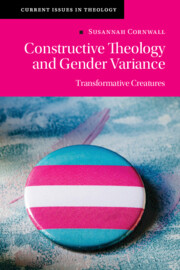Book contents
- Constructive Theology and Gender Variance
- Current Issues in Theology
- Constructive Theology and Gender Variance
- Copyright page
- Dedication
- Contents
- Acknowledgements
- Part I Setting the Scene
- Part II Telling Truths
- Part III Limits, Technology, and Health
- Part IV Transformative Creatures
- 10 Transforming Humanity
- 11 In Christ, Everything Has Changed
- 12 Transformative Creatures Reprised
- References
- Author Index
- Subject Index
10 - Transforming Humanity
Gender, Race, and Animality
from Part IV - Transformative Creatures
Published online by Cambridge University Press: 14 December 2022
- Constructive Theology and Gender Variance
- Current Issues in Theology
- Constructive Theology and Gender Variance
- Copyright page
- Dedication
- Contents
- Acknowledgements
- Part I Setting the Scene
- Part II Telling Truths
- Part III Limits, Technology, and Health
- Part IV Transformative Creatures
- 10 Transforming Humanity
- 11 In Christ, Everything Has Changed
- 12 Transformative Creatures Reprised
- References
- Author Index
- Subject Index
Summary
In Part IV of this book, entitled Transformative Creatures, I develop a constructive theology of gender variance. It encompasses accounts of theological anthropology: the truths gender tells us about ourselves, individually and collectively; our sexuate and animal statuses (Chapter 10); the hints that as humans we tend to embrace order and give a high place to social and psychological systems that allow us to manage our expectations and minimize danger; and the concomitant fact that we often create and cling to arbitrary and over-solidified delimitations in order to exercise power. It dwells on creation, with particular reference to the question of the licit limits of human technologies given God’s creative control over creatures (Chapter 11). It notes that Christ signifies a way but not the sole way to be a human, much less a creature, and does not tell the full story of what it means to be a sexed and gendered person (Chapter 11). It is eschatological, but it shows that our creaturely ends may include those accessible here and now, not just those ‘ahead’ of us (Chapter 12).
- Type
- Chapter
- Information
- Constructive Theology and Gender VarianceTransformative Creatures, pp. 281 - 308Publisher: Cambridge University PressPrint publication year: 2022

